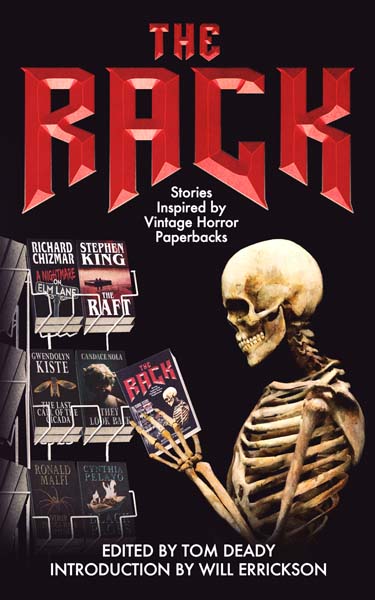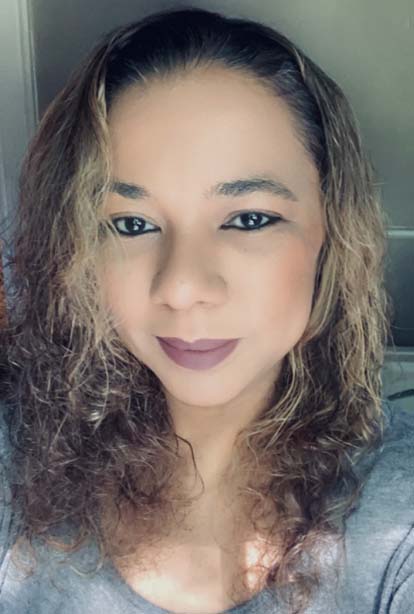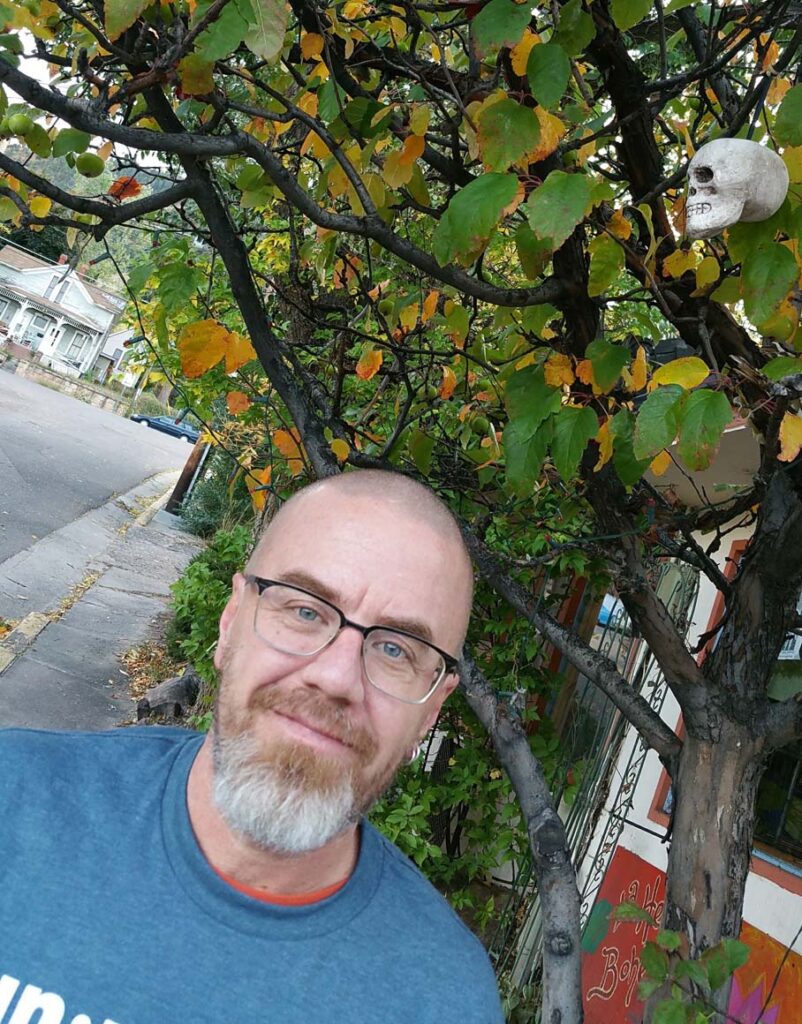Welcome back! Today I’m thrilled to spotlight some of the contributors as well as the editor of the new anthology, The Rack: Stories Inspired by Vintage Horror Paperbacks! I’m so fortunate to have a story in the table of contents alongside these wonderful authors, and it’s been such a fantastic process, from working with editor Tom Deady to that amazing cover art by Lynne Hansen.
So without further ado, let’s take it away, shall we?
Tell us a little bit about yourself and your story in The Rack.
 CANDACE NOLA: My name is Candace Nola. I’m an award-winning author from Pittsburgh PA. The creator of Uncomfortably Dark Horror, an indie horror review and publishing platform. My story in The Rack was inspired by my love of creepy dolls when I was a child, especially the porcelain baby dolls with the glass eyes. Using that as the main concept, and a few other disturbing elements, I was able to create my creepy story, “They Look Back.”
CANDACE NOLA: My name is Candace Nola. I’m an award-winning author from Pittsburgh PA. The creator of Uncomfortably Dark Horror, an indie horror review and publishing platform. My story in The Rack was inspired by my love of creepy dolls when I was a child, especially the porcelain baby dolls with the glass eyes. Using that as the main concept, and a few other disturbing elements, I was able to create my creepy story, “They Look Back.”
REBECCA ROWLAND: I am an anthology editor and dark fiction author who hails from New England, which is how I became acquainted with Tom [Deady]: I met him when we both had tables at a convention in Framingham, Massachusetts, pre-pandemic. There are a handful of creatures from myth and folklore that creep me out, and I like to exorcize them by working them into stories: most recently, I’ve written about the banshee, the siren, the wendigo, the yara-ma-yha-who. My story in The Rack, “Better by You, Better than Me,” features the diao si gui, the hanging host. According to legend, if a person is hanged, whether by choice, punishment, or misadventure, the victim haunts the area where the hanging occurred, and should it make eye contact with a living person, it may choose to change places with him or her. There are countless paintings depicting the diao si gui that frighten the hell out of me, so this story is my way of keeping those nightmares at bay (while simultaneously making a statement about the wave of 80s’ irrationality of blaming metal music for suicide and satanism).
MAX BOOTH III: My wife and I operate Ghoulish Books together, which is both a small press and indie bookstore specializing in horror. We’re just on the outskirts of San Antonio. I also write my own books and the occasional movie (We Need to Do Something is currently streaming on Hulu). On top of that, we organize and host the annual Ghoulish Book Festival every spring in downtown SATX.
My story is called “Loud and Clear” and it’s about a woman who lives on closed-down campgrounds. One night, after getting drunk and insulting her sister’s kid, she goes digging in an old storage cabin and locates a walkie talkie from her childhood, back when the camp was still operational. Soon she begins hearing a voice from the walkie talkie—the voice of a boy who should be dead. Then…you know, other horror-related things happen.
CHRISTA CARMEN: I am a horror, gothic mystery, and thriller/suspense writer from Westerly, Rhode Island, where I live with my daughter, Nell, husband, John, bloodhound/golden retriever mix, Mirabel, and five chickens, Asha, Amaya, Wind, Toby, and Spike. My debut novel, The Daughters of Block Island, won the 2023 Bram Stoker Award for Superior Achievement in a First Novel and was nominated for a Shirley Jackson Award, to my immense surprise and pleasure. I’ve also had work published in Vastarien, Nightmare, Orphans of Bliss, Year’s Best Hardcore Horror, and the Stoker-nominated anthologies, Not All Monsters and The Streaming of Hill House. I’m a big fan of all the wonderful roundtable interviews you’ve conducted in the past, Gwendolyn, and of your insightful and generous blog, so thank you for having me and all the other Rack contributors here today!
My story in The Rack is called “Blood of My Blood” and was inspired by the “[enter location or party type]-massacre” stories of the 70s and 80s (like, for instance, “slumber party massacre” or “motel massacre,” and let’s not forget the entire subgenre of “camp massacre” tales popular during this time period). Mine is a “wedding day massacre” story, but one which also draws on some of the more tongue-in-cheek, black humor vintage paperbacks of the era. Suffice it to say, the story could never be accused of taking itself too seriously, and I certainly hope readers have fun with it.
“Blood of My Blood” is about a young woman whose fiancé discovers the true nature of her family’s business on the day of their wedding, leading to a rather untraditional—and blood-drenched—ceremony. I had a blast working out the numerous death scenes, and while I won’t say too much more, I won’t dissuade you from googling “‘medical sanguinarians”… you might find yourself even more in the mood for a good old-fashioned marital bloodbath once you’ve, ahem, whet your whistle on the topic.
STEVE VAN SAMSON: I’ve been lurking in and around the indie horror scene since 2017, when I self published my first two novels “The Bone Eater King” and “Marrow Dust”. There were both what can be elevator-pitched as POST APOCALYPTIC VAMPIRES IN AFRICA and helped set the tone for what I wanted to do with this crazy little writing career. Character diversity is incredibly important to me, as is trying to find interesting new ways of exploring certain sub-genres of horror (vampires being just one). Variations on a theme can be thrilling, but I always try to find an angle I haven’t seen before. Injecting some fresh adrenaline into the familiar.
This is true for my story in THE RACK. “Lips Like a Scythe” is, on its surface, a send up of the giant bug movies of the 1950’s—THEM! (1954) and Tarantula (1955) being my personal faves. I knew my main character had to be a park ranger but wanted to present as realistic a depiction as possible. Problem was, I knew nothing beyond what I’d seen in movies which was in all likelihood, not super accurate in the first place. So, I began contacting various Ranger stations around the United States. After numerous phone calls and emails, I finally found someone in Sandy, Oregon who agreed to answer my list of questions! It was an illuminating experience. And while I still don’t know if I got everything just right, there was no question that the main character had to be named Heather.
 CLAY MCLEOD CHAPMAN: My name is Clay — and my story on The Rack is called “white pages.” For those folks who might remember the White Pages, or don’t, it was this magical tome full of every phone number, every address, for every citizen who lived within your area. It was truly a wondrous publication for those of us who liked to make prank calls back in the day when we were children. But what happens if the person who picks up the phone isn’t who you think they are? What if there’s someone waiting for you on the other end of the line?
CLAY MCLEOD CHAPMAN: My name is Clay — and my story on The Rack is called “white pages.” For those folks who might remember the White Pages, or don’t, it was this magical tome full of every phone number, every address, for every citizen who lived within your area. It was truly a wondrous publication for those of us who liked to make prank calls back in the day when we were children. But what happens if the person who picks up the phone isn’t who you think they are? What if there’s someone waiting for you on the other end of the line?
KRISTIN DEARBORN: When I heard the idea for the anthology was a love letter to those wonderful old paperbacks of the 70’s, 80’s, and 90’s, I was thrilled. I feel like we can’t even talk about those books without tipping our hats to Grady Hendrix and his Paperbacks From Hell, which brought several classics back into the mainstream. While we shouldn’t be judging books by their covers, we inevitably do, and wow, those covers were something. To write something inspired by the idea of a lurid cover, I knew I wanted to do something larger than life, and I wanted teenagers to die. I spent a while working on a piece about a summer camp and MK-Ultra while ultimately became a novella, and had to shift gears and come up with something shorter. I love creature features, love marauding animals, and decided to go with a bear. The rest, as they say, is history.
LARRY HINKLE: My name is Larry Hinkle, the least famous author you’ve never heard of. My debut collection, The Space Between, was released in February, 2024 from Trepidatio Publishing.
My story in The Rack is called “That Chemical Glow.” It’s an environmental/chemical/industrial horror story about twin brothers on the run after a drug deal goes bad. They end up hiding out in the neighborhood where they grew up, which the government condemned after two deadly chemical spills. Turns out the old neighborhood ain’t what it used to be, and the new residents are eager to make new friends.
 JEFF STRAND: I’ve published about sixty books, and after a long losing streak I won the Bram Stoker Award for my novella Twentieth Anniversary Screening. My story “Fuzzy Slippers” explores the ancient universal fear that if you put on a pair of fuzzy slippers, they’re going to bite your feet off. I do not expect to win a second Bram Stoker Award for this particular story, but I think it’s a bloody good time.
JEFF STRAND: I’ve published about sixty books, and after a long losing streak I won the Bram Stoker Award for my novella Twentieth Anniversary Screening. My story “Fuzzy Slippers” explores the ancient universal fear that if you put on a pair of fuzzy slippers, they’re going to bite your feet off. I do not expect to win a second Bram Stoker Award for this particular story, but I think it’s a bloody good time.
TOM DEADY: I’ve been a fan of the horror genre since I was a kid, though I didn’t start taking my writing seriously until much later in life. I decided to put The Rack together as a tribute to what started me on my horror genre. I talk about it in the afterword of The Rack in detail.
What are your memories of vintage horror paperbacks? Did you read them growing up, or did you know someone who did? Do you have a favorite book from that era or even a favorite cover?
 CANDACE NOLA: My first memory of the vintage paperbacks were the ones my dad read, quite a few King and Straub among them, but also Laymon, some James Herbert, and others. The covers caught my eye first, always a terrifying rodent, or demonic doll, some other type of impossibly haunted object and the half-dressed woman screaming in terror.
CANDACE NOLA: My first memory of the vintage paperbacks were the ones my dad read, quite a few King and Straub among them, but also Laymon, some James Herbert, and others. The covers caught my eye first, always a terrifying rodent, or demonic doll, some other type of impossibly haunted object and the half-dressed woman screaming in terror.
REBECCA ROWLAND: My dad was a huge Stephen King fan, so King’s books lurked everywhere in our house. I remember the cover of The Stand: the piercing red eyes of Flagg with a crow superimposed over his face; I remember Carrie’s dual face glowing blue, and I distinctly remember the cover of Night Shift because it quickly became my favorite short fiction collection, the bandaged hand with eyes peeking from the fingers. We owned the red paperback of The Bachman Books—the one with the skulls streaking along the road into the distance—and I recall that “The Long Walk,” not “Rage,” made the strongest impact on me, likely because of the body horror. When he moved to a suburb in the late 2000s, my father dropped all of those books at the local library for their annual used book sale, and weirdly enough, I ended up buying his exact copy back from a seller on eBay. It’s as if the book itself had decided that it belonged to us, to me.
MAX BOOTH III: Admittedly, I’m on the younger side of this anthology’s ToC. I was born in ’93, so I missed out on the big paperback boom of the ’80s. But I clearly remember my library having lots of old-school horror paperbacks when I was growing up. Plus my mom probably had every King paperback laying around the house, and I read those pretty much as soon as I knew how to read. Different Seasons was probably the first one I really got into, because I was obsessed with Stand By Me and I was thrilled to learn there was also a book component to the movie. I also remember reading that huge Richard Bachman omnibus early on and falling in love with The Long Walk.
My favorite cover from that era might be controversial, because even the author hated it, but I’m gonna have to go with the first-edition cover of Jack Ketchum’s The Girl Next Door. Am I influenced here as a Goosebumps kid? Quite possibly. Either way, I’ve always loved that ridiculous cover haha. I think the fact that it’s such a tonal mismatch for the actual story is what makes me appreciate it even more. Who signed off on this thing? Why was this the cover? No idea, but I am grateful it happened.
CHRISTA CARMEN: Being born in the mid-80s, I was a bit too young to be reading paperbacks right off the rack myself, but my father was a fan of the Dean Koontz/Frank M. Robinson-type science fiction / horror paperbacks (as well as Stephen King, of course) and my mother was likely to be in possession of any number of the “woman looks over her shoulder at looming house” brand of paperbacks, and was a big Phyllis A. Whitney fan.
It’s a little unoriginal, especially because I heard our esteemed editor, Tom Deady, state that his first vintage paperback was this book as well, but my favorite book from that era AND favorite cover is the shiny ‘Salem’s Lot cover with the single red drop of blood glistening from the embossed vampire’s fang.
STEVE VAN SAMSON: My mom was always a voracious reader, but there were never horror books (or movies) in the house. This “scare embargo” forced me to constantly peruse the spinning racks in the kids sections of our town and school libraries for anything on the freakier side of things. The books that most stick out in my mind (besides the short story types like “Scary Stories To Read In The Dark” & “Tales From The Midnight Hour”) are definitely “Bunnicula” by Deborah & James Howe and The Samantha Slade books by Susan Smith. As for cover art, the second Samantha Slade book, “Confessions of a Teenage Frog” has really stuck with me. I remember staring at it in total fascination for hours. It depicts what was probably my first taste of body horror, as our hero Samantha gapes in “sort of abject terror” as her hands and arms get all froggy. Great stuff!
CLAY MCLEOD CHAPMAN: I have distinct memories of the Deltaville Market down in Virginia. They had a spinner rack at the front of their store… Two or three, as a matter of fact. One was always bodice rippers. The other was horror. When I was young, and my mother was waiting her turn at the checkout counter, I would brave the horror spinner and see if I could make a full rotation without flinching. And don’t get me started on actually taking a book off the rack and opening it. That was just forbidden. My heart couldn’t handle it. Especially the die-cut covers with the hidden images inside, where the book was demanding you engage with it, open it, in order for its true terror to reveal itself to you. That was just too much for me at that age. I never read those books as a kid, but the covers are still with me. PIN? THE TRIBE? Too much.
KRISTIN DEARBORN: When I was a kid I wasn’t allowed to watch scary movies, but had carte blanche to read whatever I wanted, be it from the local library, or from the boxes of paperbacks I discovered in my own attic. At home, I found Stephen King (The Stand, ‘Salem’s Lot, Cujo) Harvest Home, Rosemary’s Baby, and more. I remember powering through The Stand at a very young age (eight, maybe?) and didn’t get a lot of the nuances there. At the library I devoured even more, they had the titular black wire racks. I read everything Michael Crichton had written to that point. I devoured Koontz. Most embarrassingly, though, I was kind of obsessed with Piers Anthony’s Firefly. In retrospect, this is very cringe (as the kids say), I’m pretty sure everything about the book was god-awful. I’d never read anything with so much sex in it, horror sex, (though Koontz has some sex scenes, Crichton and King largely don’t) horror sex linked to animal biology and pheromones. I didn’t have the context back then to articulate how WRONG so much of the book is, would never recommend it or read it now, but it elevated my perception of what was horrific beyond the other titles I’d read. One of my favorite horror tropes is animal biology warped into monsters—Koontz does this so well in Watchers, I play with it myself in my novella Woman in White.
 LARRY HINKLE: I read ALL the paperbacks growing up. My mom was a huge horror fan, and my dad built a bookshelf for her that took up an entire wall in our living room. (Man, I wish I had some of those books now.) I was allowed to read anything I could reach. And I was a tall kid. (Unfortunately, I quit growing after sixth grade and have been stuck at 5’8″ ever since.)
LARRY HINKLE: I read ALL the paperbacks growing up. My mom was a huge horror fan, and my dad built a bookshelf for her that took up an entire wall in our living room. (Man, I wish I had some of those books now.) I was allowed to read anything I could reach. And I was a tall kid. (Unfortunately, I quit growing after sixth grade and have been stuck at 5’8″ ever since.)
My favorite book from that era is probably the same as everyone else’s: Night Shift by Stephen King. The one with the picture on the cover of a hand wrapped in gauze with eyeballs peeking out. It’s still the single best author collection I’ve ever read.
JEFF STRAND: My memory is that you could go into a grocery store and they’d be right there by the checkout line, as an impulse purchase! My local magazine/comic/bookstore had a robust horror section, filled with Zebra, Leisure, etc. releases, all of them face-out for easy browsing. There was a massive amount of available stuff, but the challenge came when I was looking for specific books. In the days before online retailers, if a horror novel was past its very brief window of life on the shelves, my only choice was to search used bookstores. It took years to track down a copy of Ketchum’s Off Season, which I desperately wanted to read after it was discussed in Deep Red magazine. My favorite book of the era was R. Patrick Gates’ Grimm Memorials.
 TOM DEADY: When I was in my early teens, every store – whether it was a supermarket, drugstore, or convenience store – had a spinny rack. I spent a lot of happy hours spinning those racks, studying the lurid covers and reading the back copy until I found just the right book.
TOM DEADY: When I was in my early teens, every store – whether it was a supermarket, drugstore, or convenience store – had a spinny rack. I spent a lot of happy hours spinning those racks, studying the lurid covers and reading the back copy until I found just the right book.
I read a ton of them growing up and owned most of them. My brother, Mike, used to let me borrow his books (he had WAY more than I did, and still does!) if I hadn’t read them.
I often credit ‘Salem’s Lot for the one that got me started in horror. The original embossed face with the single drop of red blood…I can remember finding that on the rack all these years later. But there are so many others that come to mind; Nightwing, The Keep, Off Season, Night Shift, Audrey Rose…so many great covers.
So many thanks to all the contributors of The Rack for being part of this week’s roundtable! Join us next week as we discuss even more about vintage horror paperbacks!
Happy reading!
